Linear Recurrent Double Sequences with Constant Border in M2(F2) are Classified According to Their Geometric Content
Abstract
:1. Introduction
- A recurrent double sequence remains constant if and only if it satisfies the relation for . Exactly 1024 sequences, i.e., a quarter of 4096, are constant.
- All homomorphic recurrent double sequences over can be also generated by systems of substitutions. Moreover, most of them can be easily associated a geometric content, and there are only 90 such contents occurring in the 4096 homomorphisms.
- Recurrent double sequences produced by homomorphisms lying in the same class of conjugation (tend to) have the same geometric content. This fact is at the first sight a surprise, and was not foreseen by Lemma 1.6. Moreover there are two different kinds of exceptions:
- A
- A normal exception is the situation when two homomorphisms in a class of conjugation of six homomorphisms or one homomorphism in a class of conjugation of three homomorphisms produce a constant recurrent double sequence, although the other homomorphisms in the class of conjugation remain in the same (non-uniform) type.
- B
- A sporadic exception is the situation in which some recurrent double sequences with different geometric content are produced by conjugated homomorphisms. Only some few classes of conjugation (only 33 classes in 736) split in different geometric contents. Pairs of contents occurring in sporadic exceptions are from sets that were called later type 1 and type 2, type 2 and type 19, type 19 and 74, type 2 and type 74. See the Classification for the definition of those geometric types.
- A linear recurrent double sequence over remains constant if and only if it satisfies the relation . Exactly 256 sequences, i.e., of 4096, are constant. Moreover, the set of matrix triples producing constant sequences is a union of classes of conjugation of triples, because the given condition is compatible with the conjugation. Otherwise said, the normal exception noticed in for homomorphic double sequences does not take place anymore.
- All linear recurrent double sequences over can be also generated by systems of substitutions. Moreover, most of them can be easily associated with a geometric content, and there are only 90 such contents occurring in the 4096 homomorphisms. The geometric contents are very similar with those met in the homomorphic double sequences of . More on this is discussed in the third section.
- Recurrent double sequences produced by matrix triples lying in the same class of conjugation always have the same geometric content. More exactly, we will prove in the next section that homomorphisms lying in the same class of conjugation produce isomorphic recurrent double sequences over . Consequently, the fact that the geometric types are unions of classes of conjugation is no more surprising. Both the normal and the sporadic exceptions noticed in homomorphic double sequences over completely disappear in . The sporadic exception was produced by the fact that the projection is sometimes bad and can map neighboring different elements from a double sequence onto neighboring equal elements in the other one.
2. Linear Recurrent Double Sequences Over Rings
- 1.
- Let be an element. Then the recurrent double sequence defined by is the projection of the recurrent double sequence realized by the application . In particular, the recurrent double sequence defined by lives in the principal ideal .
- 2.
- Let be units. Then the linear double sequences defined by , and are isomorphic. They are also isomorphic with the linear double sequence defined by .
- 3.
- All recurrent double sequences produced by triples in some class of conjugation are isomorphic.
3. Substitution
- In other words: in every x-position of Y occurs an element of .
- The last symbol denotes a function called substitution. The natural number s must be and is called expansion factor.
- The elements of seen as (finite) subset of are called substitution rules.
- The cardinality r of is the number of substitution rules.
- 1.
- .
- 2.
- .
- 3.
- There exists such that and .
4. Skeleton
- Let . There exists a system of word substitutions generating the sequence s.
- Let . There exists a system of word substitutions generating the sequence t.
- For some , for all .
5. Convergence and Geometric Content
- there exist an matrix M occurring in m-position in a,
- for all i, is a connected union of m-translations of M,
- for all i, .
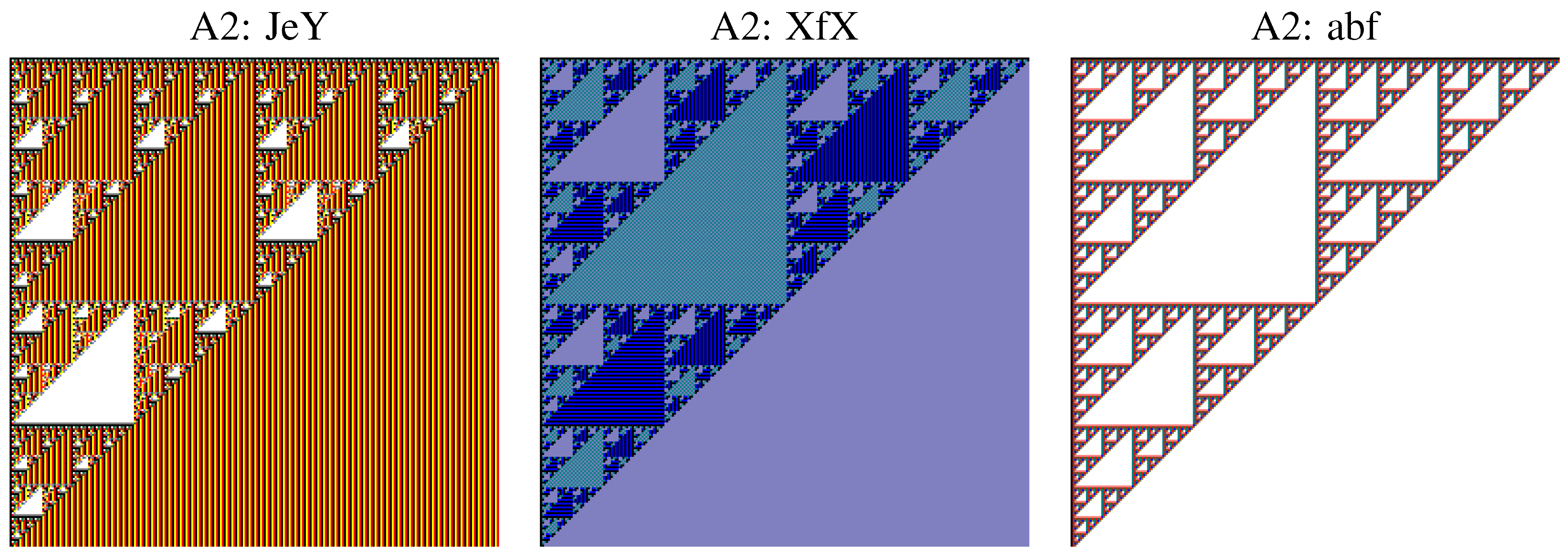
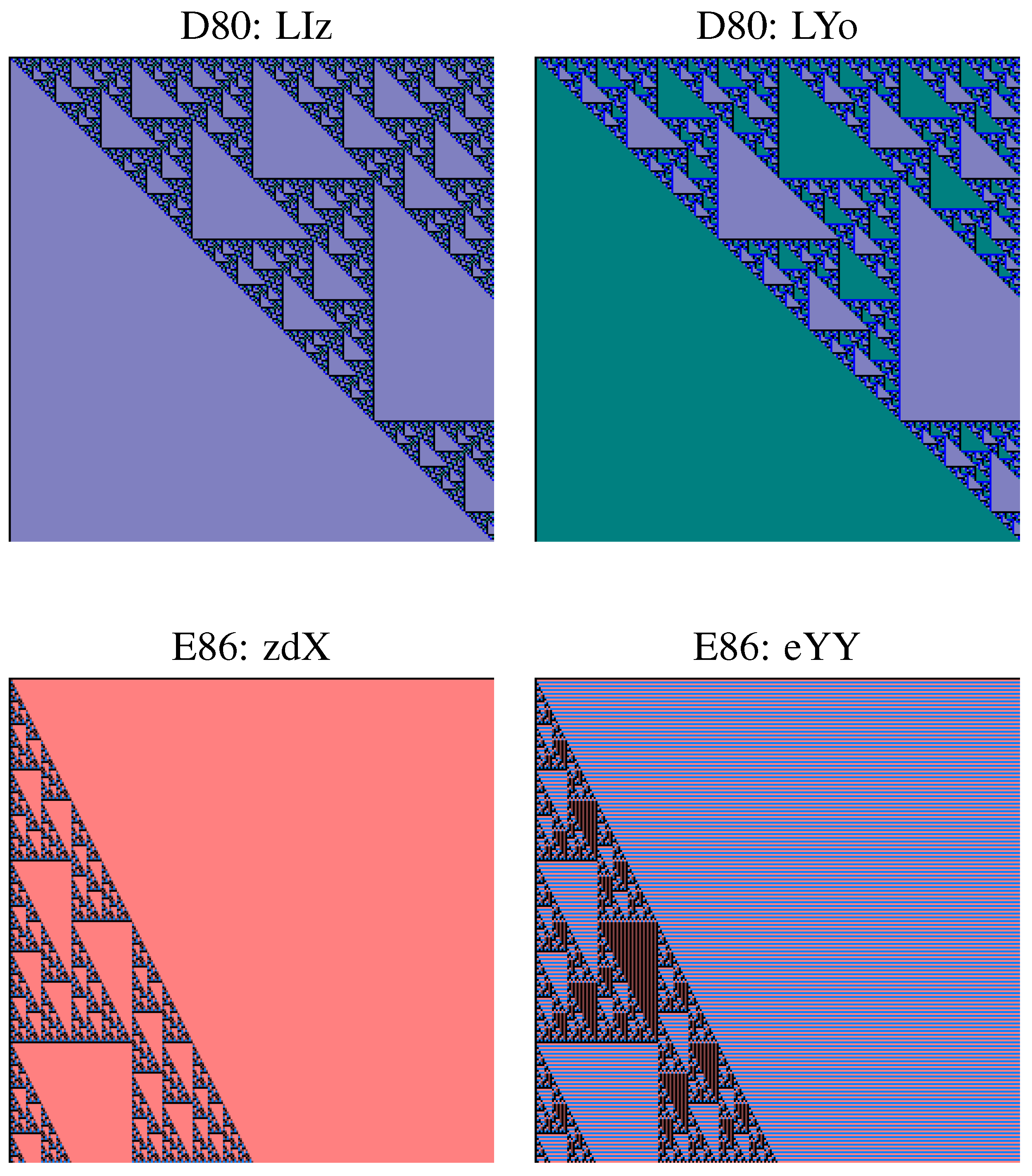
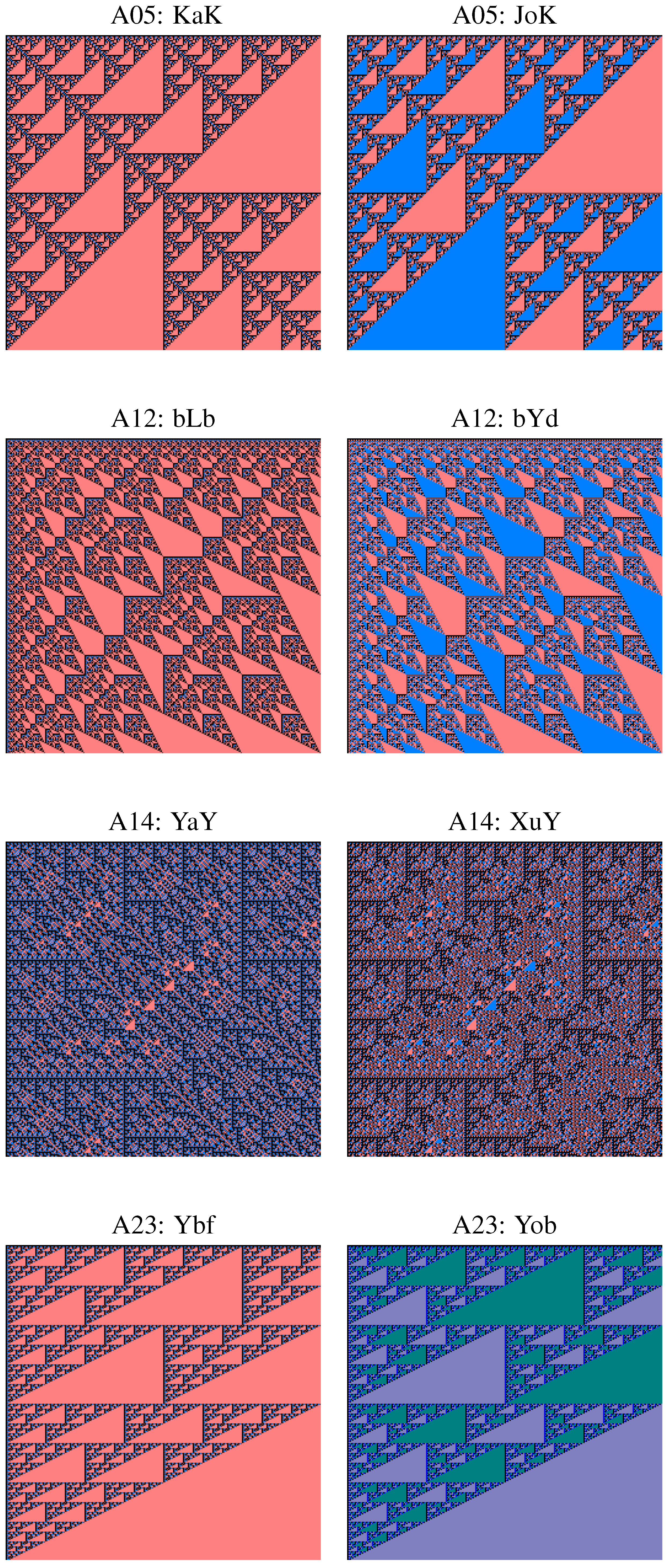
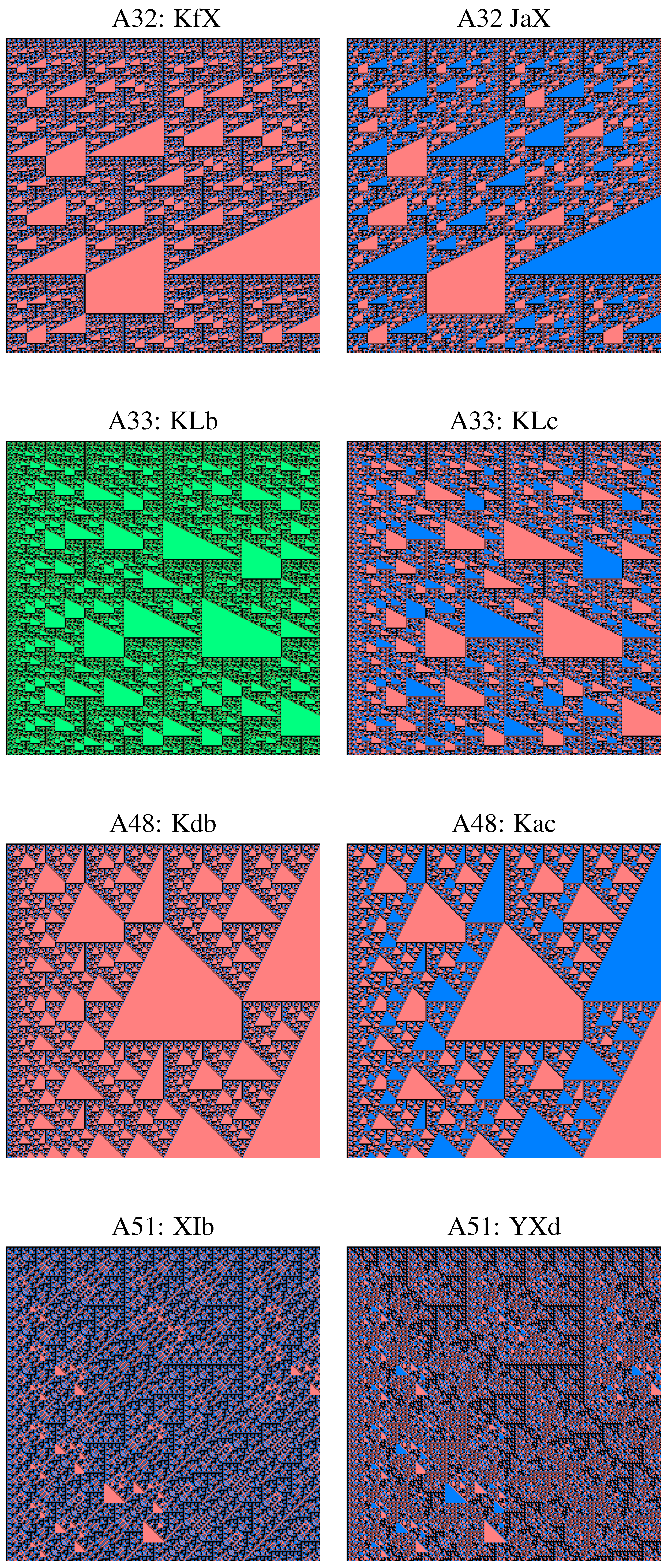

6. Primitive Double Sequences
7. Classification
- Two linear recurrent double sequences over with constant border are isomorphic if and only if they belong to the same class (mirrored class of conjugation) or are both constant.
- There exist non-isomorphic recurrent double sequences having the same skeleton.
- There exist recurrent double sequences in same geometric type, whose skeletons have the same substitution type and the same number of rules, but who have however different skeletons.
- Many of the 90 geometric types contain double sequences with different types of substitution.
- A, if . (51 types)
- B, if . (17 types)
- C, if . (4 types)
- D, if . (11 types)
- E, if . (4 types)
- F, if . (3 types)
- We denote with the symmetry around the diagonal , with the symmetry around the diagonal and with m the median symmetry. When we say that a geometric type fulfills some symmetry, we mean that the geometric content, as Hausdorff limit, does it.
- We denote by t the fact that a half limit is isometric with the other half by translation. The absence of symmetry is abbreviated .
- We describe a geometric type in the following way:number name, symmetry, number of elements, number of classes.
- This line is always followed by the list of skeletons occurring in the type, each of them given together with the list of its own classes.
- If there are different skeletons in the same geometric type and if they have the same type of substitution and the same number of rules, then those skeletons are numbered like “Skeleton 1”, “Skeleton 2”, etc.
- Every name of a class is followed by its number of elements.


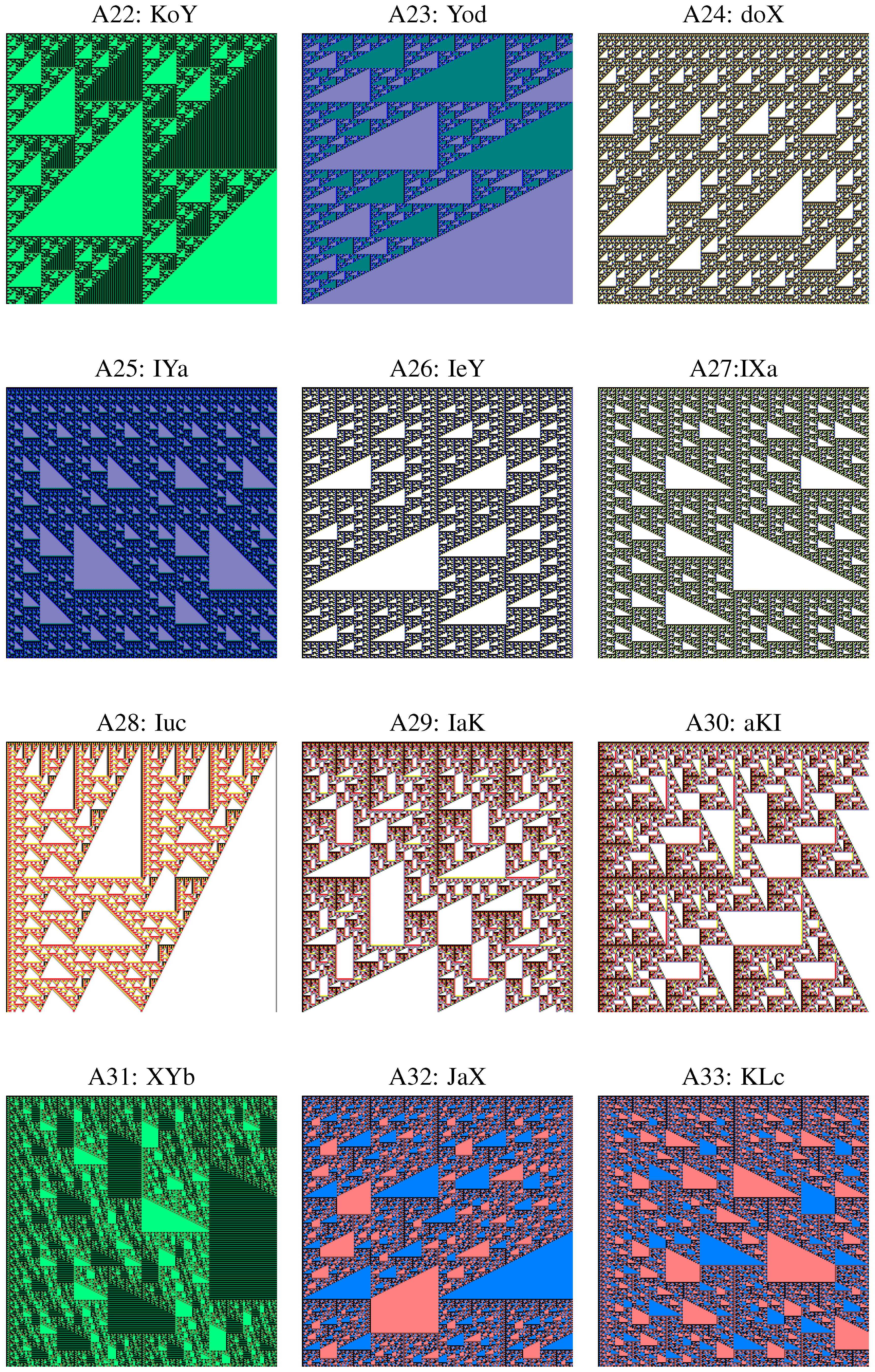
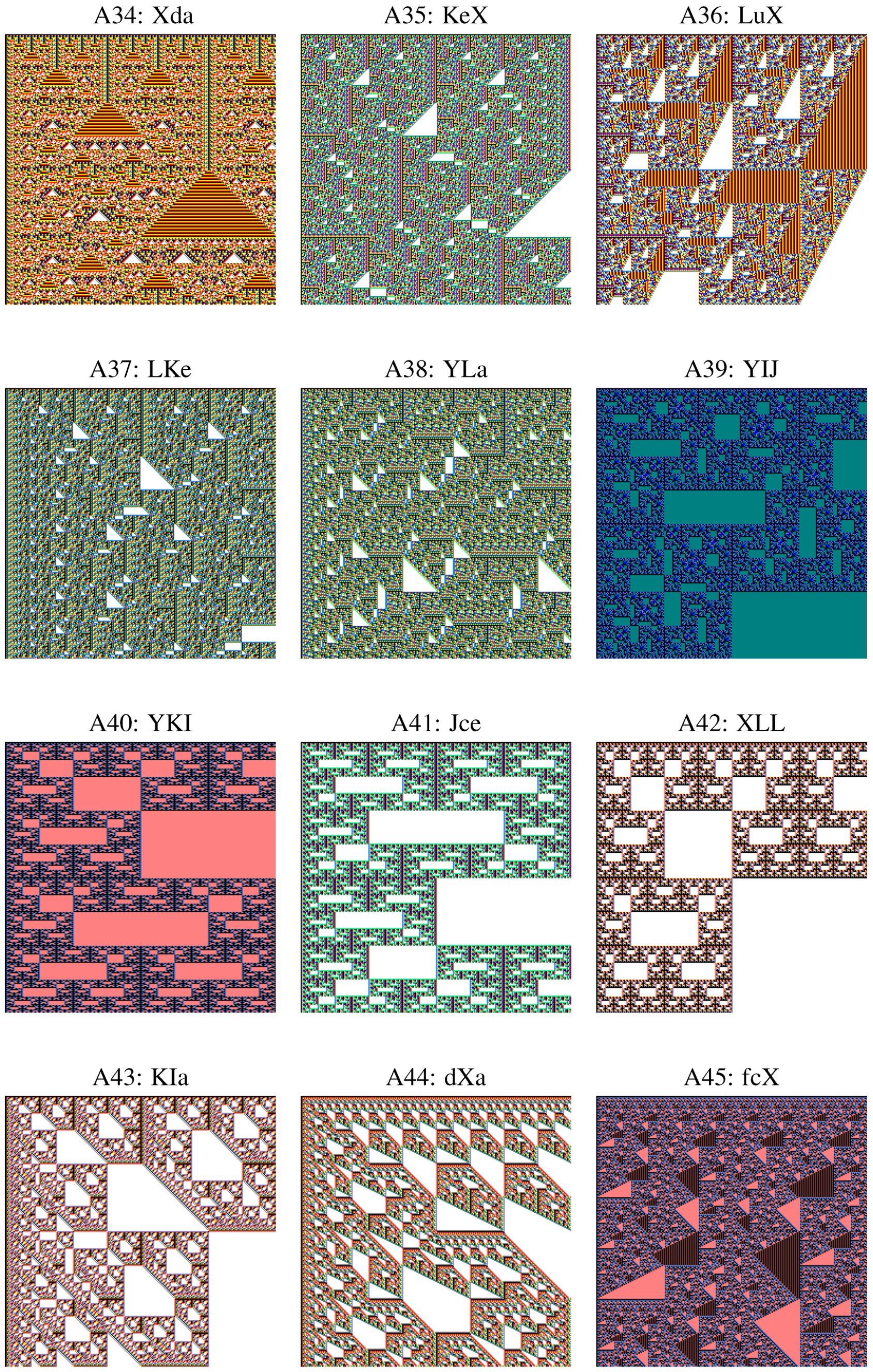
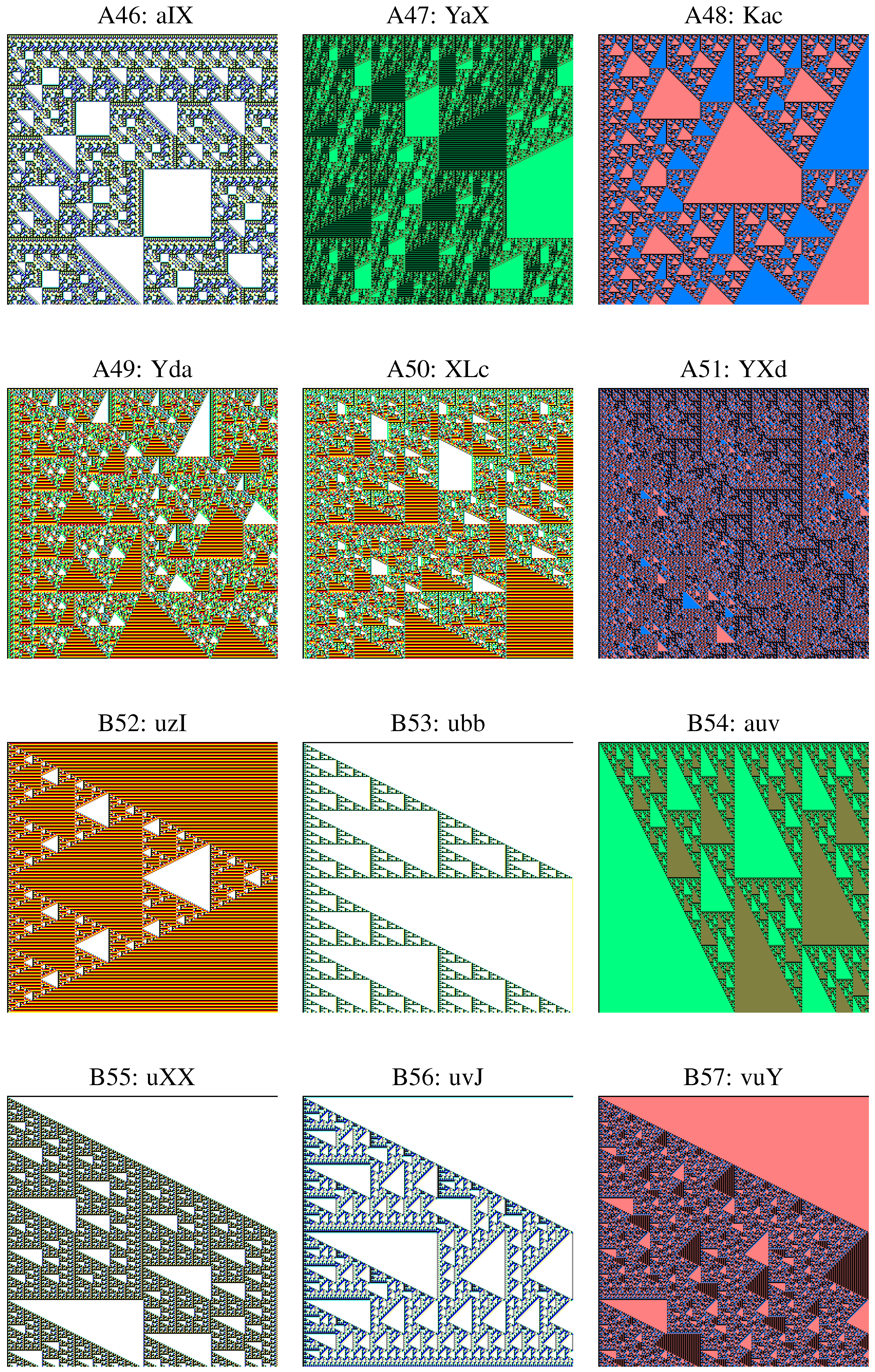

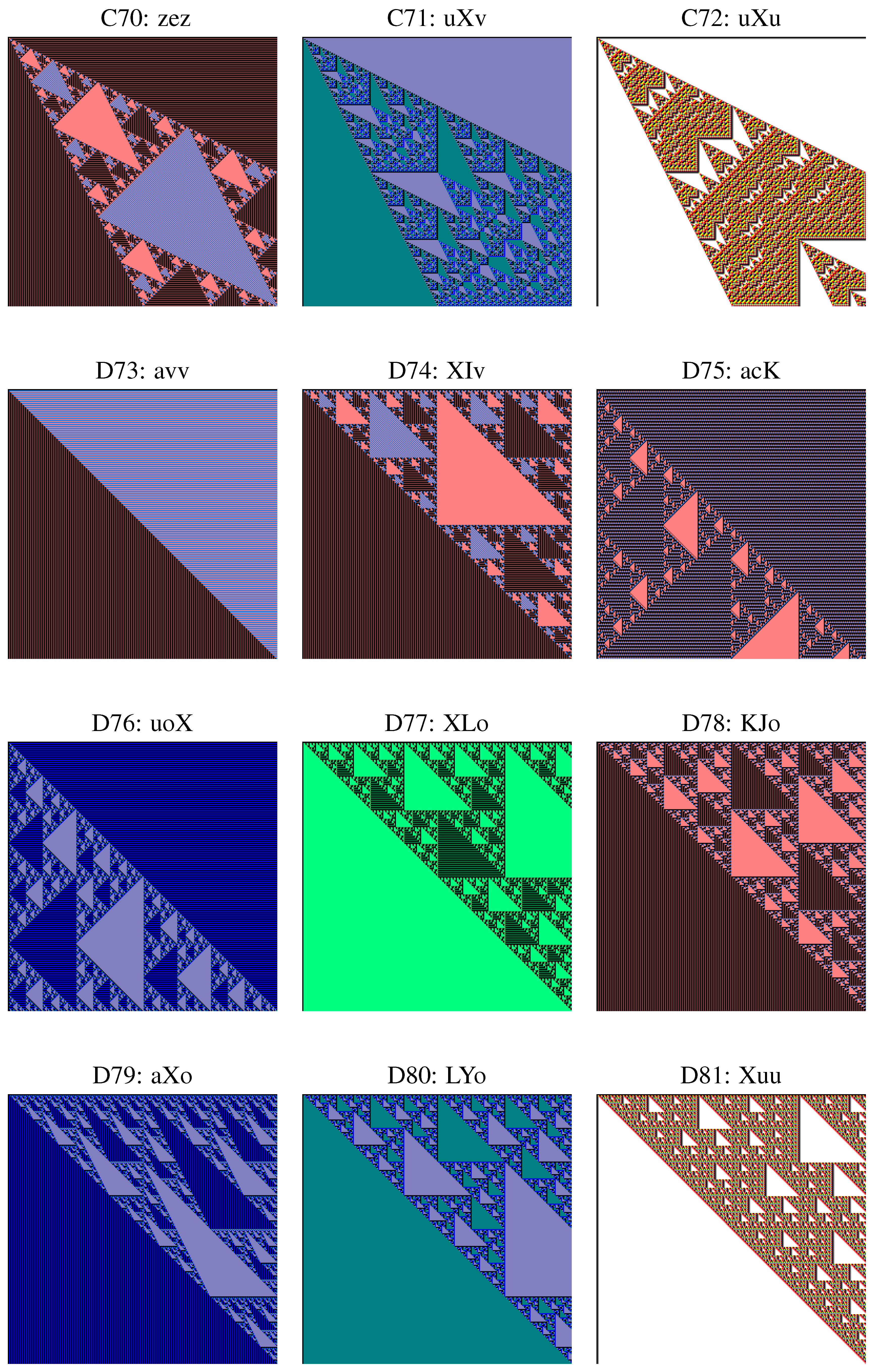
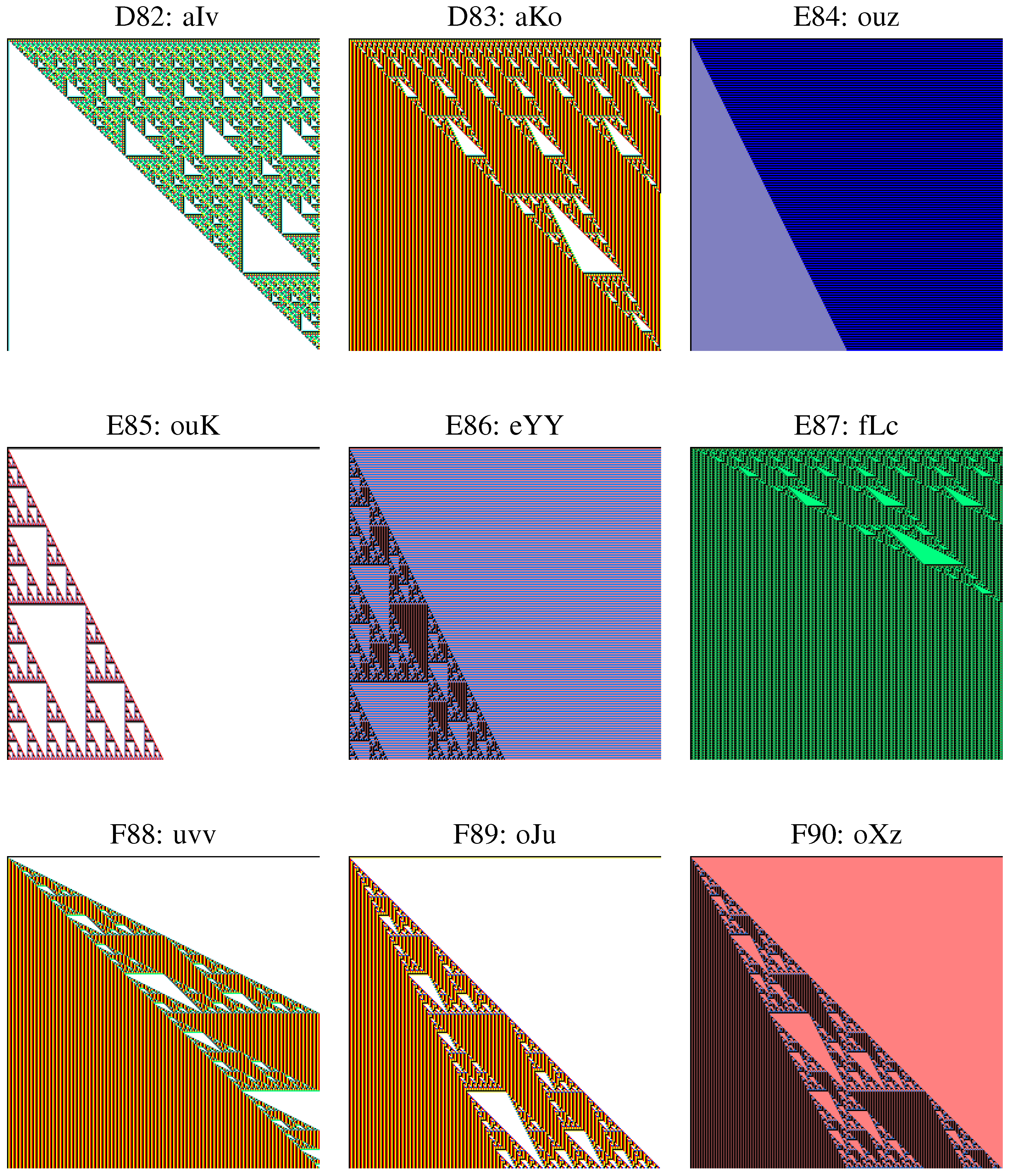
8. Affine Recurrence Rules and Two Secret Types
- All these double sequences are generated by systems of substitutions.
- For non-constant double sequences ABC, adding a constant D in the recurrence does not change the geometric type.
- For most of the triples ABC generating constant double sequences, the various types ABCD generate double sequences in one of the 90 geometric types given above. The geometric type depend only on the triple ABC, and not on the constant that have been added in the recurrence formula.
- There are only two new geometric types revealed in the (formerly) constant double sequences, as follows:
- A91 Byzantine Mosaics, , got for example by all XIXD with . These sequences are primitive. All XIXD are of type with 12 rules and with the same skeleton for all .
- B92 Double Triangles, , got for example by ubYD. These sequences have periodic domains and a conventional geometric content. All ubYD are of type with 12 rules, and have again the same skeleton for all .

References
- Prunescu, M. Recurrent double sequences that can be generated by context-free substitutions. Fractals 2010, 18, 65–73. [Google Scholar] [CrossRef]
- Prunescu, M. Undecidable properties of recurrent double sequences. Notre Dame J. Formal Logic 2008, 49, 143–151. [Google Scholar] [CrossRef]
- Prunescu, M. Self-similar carpets over finite fields. Eur. J. Combinatorics 2009, 30, 866–878. [Google Scholar] [CrossRef]
- Passoja, D.E.; Lakhtakia, A. Carpets and rugs: An exercise in numbers. Leonardo 1992, 25, 69–71. [Google Scholar] [CrossRef]
- Prunescu, M. Recurrent two-dimensional sequences generated by homomorphisms of finite abelian groups with periodic initial conditions. Preprint 2010. http://home.mathematik.uni-freiburg.de/prunescu/prunescu.html To appear in Fractals.
- Prunescu, M. Counterexample to context-free substitution in recurrent double sequences over finite sets. Preprint 2010. http://home.mathematik.uni-freiburg.de/prunescu/prunescu.html.
- Allouche, J.-P.; Shallit, J. Automatic Sequences-Theory, Applications, Generalizations; Cambridge University Press: Cambridge, UK, 2003. [Google Scholar]
- Allouche, J.-P.; Shallit, J. The Ubiquitous Prouhet-Thue-Morse Sequence; Sequences and their applications (Singapore 1998), springer series discrete mathematics in theoretical computer science; Springer: London, UK, 1999; pp. 1–16. [Google Scholar]
- Muchnik, A.A.; Pritykin, Y.L.; Semenov, A.L. Sequences close to periodic. Russ. Math. Surv. 2009, 64, 805–871. [Google Scholar] [CrossRef]
- Willson, S.J. Cellular automata can generate fractals. Discrete Appl. Math. 1984, 8, 91–99. [Google Scholar] [CrossRef]
- Mandelbrot, B.B. The Fractal Geometry of Nature; W.H. Freeman and Company: San Francisco, CA, USA, 1982. [Google Scholar]
- Kari, J. Theory of cellular automata: A survey. Theor. Comput. Sci. 2005, 334, 3–33. [Google Scholar] [CrossRef]
- Wolfram, S. A New Kind of Science; Wolfram Media: Champaign, IL, USA, 2002. [Google Scholar]
- Penrose, R. Pentaplexity. Math. Intell. 1979, 2, 32–37. [Google Scholar] [CrossRef]
- Wang, H. Proving theorems by pattern recognition. Commun. ACM 1960, 3, 220–234. [Google Scholar] [CrossRef]
- Robinson, R.M. Undecidability and nonperiodicity for tilings of the plane. Invent. Math. 1971, 12, 177–209. [Google Scholar] [CrossRef]
- Grunbaum, B.; Shephard, G.C. Tilings and Patterns; Dover Publications: Mineola, NY, USA, 2011. [Google Scholar]
- Lindenmayer, A.; Prusinkiewicz, P. The Algorithmic Beauty of Plants; Springer Verlag: Berlin, Germany, 1996. [Google Scholar]
- Rozenberg, G.; Salomaa, A. Lindenmayer Systems: Impacts on Theoretical Computer Science, Computer Graphics, and Developmental Biology; Springer Verlag: Berlin, Germany, 1992. [Google Scholar]
- Baake, M.; Moody R., V. (Eds.) Directions in Mathematical Quasicrystals; CRM Monograph Series; AMS: Providence, RI, USA, 2000. [Google Scholar]
- Moody, R.V. The Mathematics of Aperiodic Order. Proceedings of the NATO Advanced Study Institute on Long Range Aperiodic Order; Kluwer Academic Publishers: Norwell, MA, USA, 1997. [Google Scholar]
- Frettlöh, D. Duality of model sets generated by substitution. Rom. J. Pure Appl. Math. 2005, 50, 619–639. [Google Scholar]
- Perron, O. Zur Theorie der matrices. Math. Ann. 1907, 64, 248–263. [Google Scholar] [CrossRef]
© 2011 by the authors; licensee MDPI, Basel, Switzerland. This article is an open access article distributed under the terms and conditions of the Creative Commons Attribution license (http://creativecommons.org/licenses/by/3.0/).
Share and Cite
Prunescu, M. Linear Recurrent Double Sequences with Constant Border in M2(F2) are Classified According to Their Geometric Content. Symmetry 2011, 3, 402-442. https://doi.org/10.3390/sym3030402
Prunescu M. Linear Recurrent Double Sequences with Constant Border in M2(F2) are Classified According to Their Geometric Content. Symmetry. 2011; 3(3):402-442. https://doi.org/10.3390/sym3030402
Chicago/Turabian StylePrunescu, Mihai. 2011. "Linear Recurrent Double Sequences with Constant Border in M2(F2) are Classified According to Their Geometric Content" Symmetry 3, no. 3: 402-442. https://doi.org/10.3390/sym3030402



